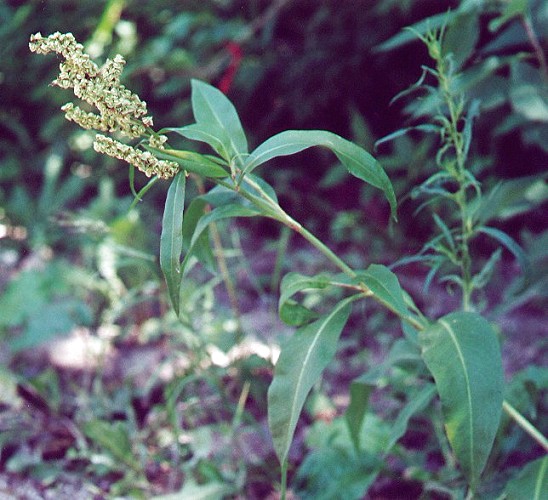Rumex altissimus Alph. Wood
Tall Dock

Native
CC = 2
CW = -3
MOC = 58
© DETenaglia
Rumex altissimus Alph. WoodTall Dock | |
 |
Native CC = 2 CW = -3 MOC = 58 |
© DETenaglia |
|
Family - Polygonaceae Stems - To +1m tall, often reclining with age, herbaceous, glabrous, from big deep taproot, typically simple but sometimes branched below the inflorescence, with darker green striations. Leaves - Alternate, petiolate, sheathing. Ocrea scarious, drying to brown, NOT fringed with ciliate bristles, typically deciduous by fruiting period. Petiole to 4cm long. Blades to +20cm long, +/-5cm broad, entire, lanceolate to lance-elliptic, acute to acuminate at apex, fairly abruptly constricted at base to petiole, glabrous. Margins only slightly undulate.
Inflorescence - Terminal verticillate racemes in a panicle to +/-30cm tall, dense. Branches of panicle ascending. Pedicels of flowers to 1cm long, jointed below middle, glabrous.
Flowers - Imperfect. Fruiting sepals green, drying to a brownish-copper color, to 6mm long, 5mm broad, entire. Tubercles 1, to 3.5mm long, 1.1mm broad. Achenes 3-sided, 3mm long, dark brown.
Flowering - April - May. Habitat - Moist ground by streams, sloughs, and ponds, thickets, waste ground, railroads. Origin - Native to U.S. Other info. - This species of Rumex is quite common throughout Missouri. The plant seems to prefer slightly moist ground but can grow in a variety of conditions because of its big taproot. Photographs taken at the Kansas City Zoo, 5-17-00, and at the Dr. Frederick Marshall Conservation Area, Platte County, MO., 5-6-01. |